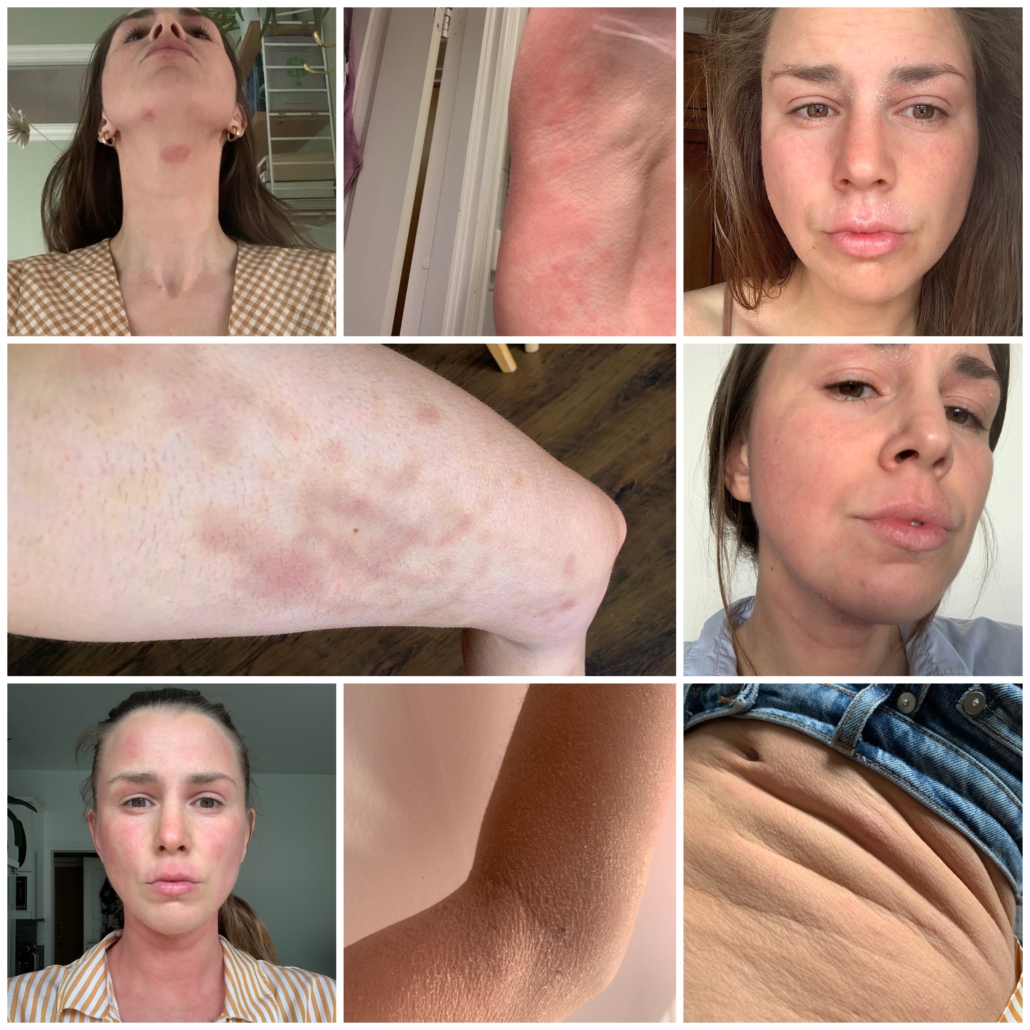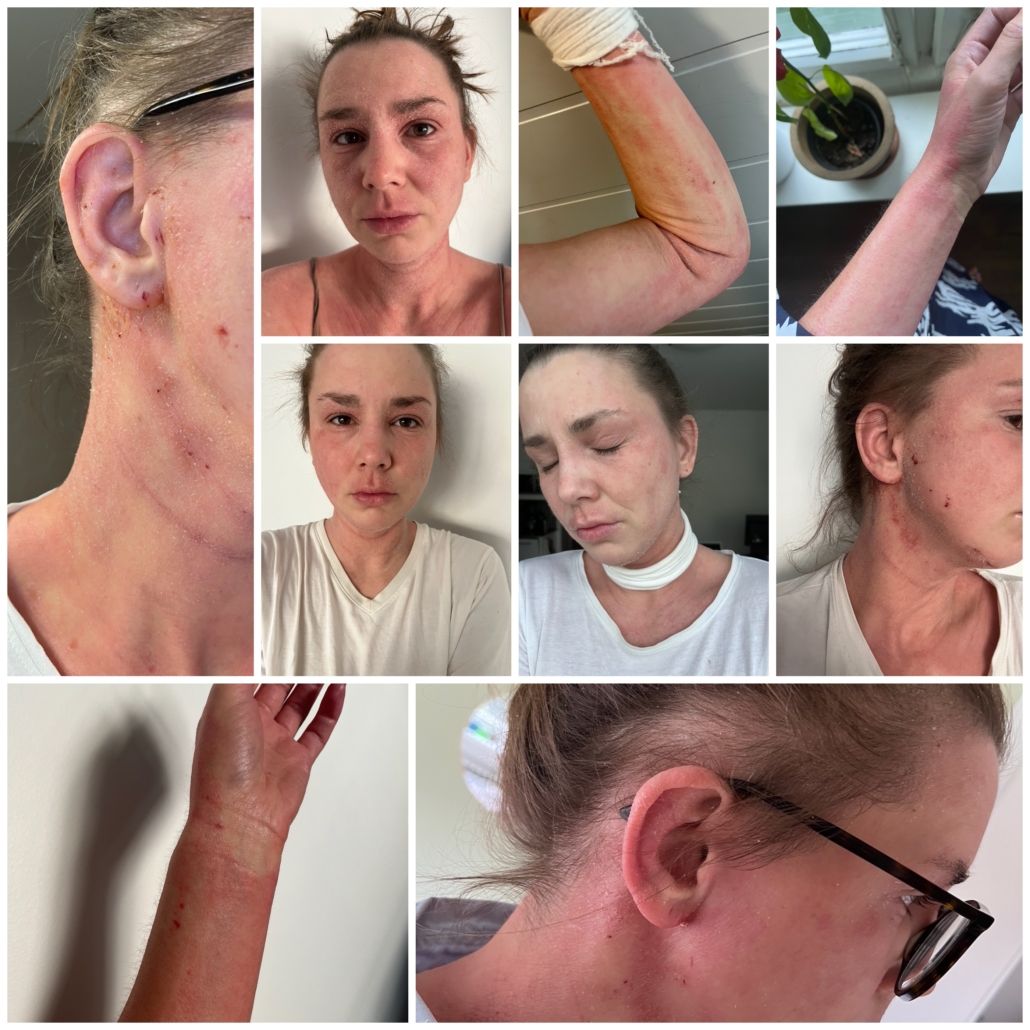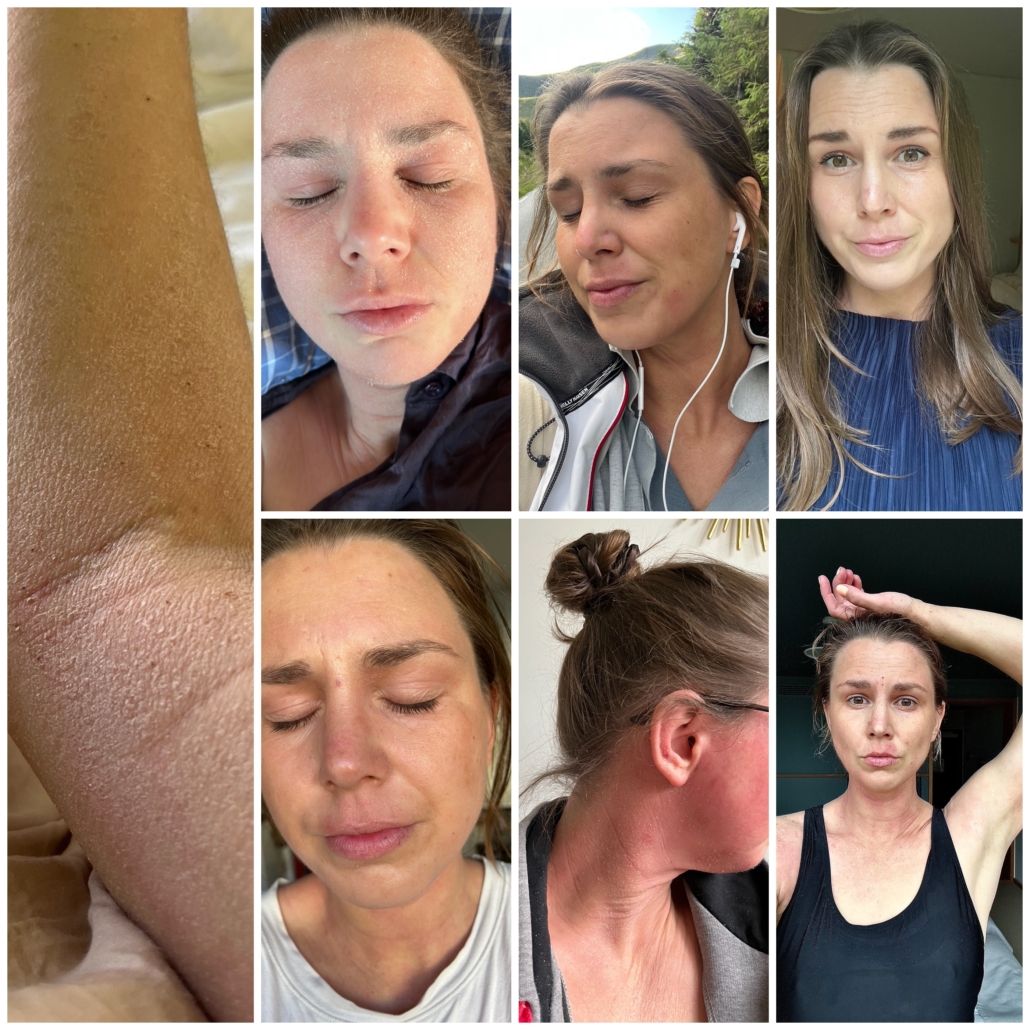Julia’s Topical Steroid Withdrawal Story

Before TSW (Topical Steroid Addiction symptoms)
“You will have to live with your troubles for the rest of your life. Here is a stronger ointment to use in the future. Come back if it doesn’t work, and we’ll try something else [stronger].”
That’s what one of the many dermatologists I visited told me. He gave my new rashes a quick glance before focusing on the screen to prescribe more ointments and sometimes even tablets. He always asked surprisingly few questions compared to the amount of information I provided during the visits. Since I was a small child, I have struggled with eczema, which escalated during my late teens and adulthood. The rashes no longer looked like the eczema I had as a child. Additionally, new symptoms such as spreading skin issues, a constant feeling that a cold was on its way, and new allergic reactions arose that I couldn’t explain. For many years, I lived a very healthy life, yet my body seemed to only get sicker and sicker.
“This is the most harmless ointment on the market, and you can use it regularly for a long time on your face. […] Do you dare to use it on your eyelid?” asked the female dermatologist.
I was taken aback and gave a diffuse answer that it should be okay if you say so, right? What stance should I, as a patient, take? For many years, I was prescribed more and stronger corticosteroids. The most well-known in the category of steroids is probably the over-the-counter hydrocortisone ointment. Then there are immunosuppressive drugs, usually known as Protopic/Tacrolimus or Elidel. I was instructed to continue applying even after tapering off and use amounts equivalent to the size of a plum. I ended up in hospitals abroad more than once because my skin was in turmoil.
“You may get some thinning of the skin, but otherwise, there are no common side effects.”
That’s not the only side effect I would later learn about. Instead, all my new illnesses and intensified skin problems stemmed from the use of these drugs. Among others, I experienced steroid induced rosacea, eczema herpeticum, intense bruising and scarring, candida, scabies, blood/skin infections related to odd activity of white blood cells and also I regularly had worsened issues with illness related to my lungs and throat. I probably developed a dependence on corticosteroids as a child without knowing it. When hydrocortisone and mildison no longer worked, and my body became more accustomed, doctors had to resort to more potent drugs, which also became ineffective. These came with a horde of addiction symptoms. It’s like comparing it to an alcoholic who slowly stops responding to alcohol and needs to drink more to feel the high, experiencing physical withdrawal symptoms when the drug is absent. I felt involuntarily and legitimately in a state of addiction.
“I like that you are skeptical about steroids; many want them prescribed too easily. I have never used them myself,” said the last dermatologist I met as he led me out of the room after trying to prescribe more of the most potent steroids.
It was during a visit that I made to appeal for help in tapering down and discontinuing the use of steroids altogether. But what I got was new prescriptions for strong ointments and a suggestion to start antidepressant tablets to suppress the symptoms of despair over the fact that my largest organ, the organ that protects all others, was giving up. I should have said something, but I became speechless. This doctor had met me for five minutes and suggested new strong drugs to cover up side effects from others.
As if by chance, or by carefully programmed algorithms, I came across a video of a person who looked like me with the reference “Topical Steroid Withdrawal” (TSW). It was like I finally got an explanation for the limbo of health conditions I had been in since my teens from thousands of people who share the same story as me. With these new insights and a community of like-minded individuals confirming what I had previously suspected, I declined all medication and began tapering off from the strongest steroids and immunosuppressive drugs on my own and switched to over-the-counter hydrocortisone ointment. The tapering took over half a year as withdrawal symptoms crept in. On my last two uses, the ointments irritated more than helped, and it was time to stop altogether. Never again. Fortunately, I also found a general practitioner who accepted the mistreatment I had received for so long and has been able to support me where possible, without ever offering me any new steroids.
The inflammation in my body was so pronounced. Everything was red, hot, and burning. The condition is called “Red Skin Syndrome” for a reason. At the same time, I was constantly freezing in the middle of summer as regulating my body temperature became impossible. I regularly got Raynaud’s syndrome on my fingers and toes. Despite eating, my weight plummeted. My hair started falling out in large clumps until my scalp was visible, and I scratched off the hair on my body. My lymph nodes swelled and seemed permanently enlarged. The itching was and is not like the eczema I experienced. This is a completely debilitating itch that has made me unable to do anything other than sit on the floor and scratch for hours until my skin looks like a raw piece of meat. My skin stiffens, flakes in enormous amounts, cracks, oozes, bleeds. It is so sensitive that it is impossible to move without resistance. Some days, it’s not even possible to lie still without pain. I have insomnia even though I just wish to go into hibernation until the worst is over. The body reacts to everything in the environment; it becomes hopeless to avoid everything that makes the body react. Everything from food, materials, central heating, and household chemicals to the weather.
This is not a disease. These are withdrawal symptoms that are preventable. The symptoms have been terribly exhausting and two years later, still control my life. Around the clock, it is a constant process of taking care of myself physically and, equally, mentally. I could easily have undergone a deep depression now if I hadn’t actively worked on my mental health. As a result of grief over the life I can’t live and chronic pain, I do not recognize myself. Life is on autopilot in a state that much of healthcare doesn’t want to acknowledge. My conviction that a life without steroids is the right and only way forward grows stronger as time goes on, and I see more and more signs that my body is healing itself with the right conditions. My hope is that tomorrow is a little easier than yesterday, and for every day that passes, it’s a day closer to a healthy body – free from steroids.

Beginning of TSW
My journey is not over. But I hope by sharing my story, I can highlight the issue of how we use these drugs today and the system of dependence and disease it entails. I have a few wishes listed below for those working in healthcare, the pharmaceutical industry, research, education, regulation, or funding:
- Make it mandatory for doctors, and also pharmacists, to be informed about and to inform patients of the side effects. And under no circumstances guarantee that a drug is safe.
- Be more restrictive in prescribing corticosteroids; do not prescribe four tubes of the most potent steroids meant to last over a year. It indicates that it is the amount to be used.
- Doctors should take into account the history of treatments a patient has used, even if they have not treated the person before. Consistently needing an increased or stronger medication because the initial prescriptions become ineffective should always be a warning sign.
- Healthcare should be synonymous with wellness. If doctors could investigate why certain rashes occur instead of suppressing the symptoms, many would have avoided unnecessary withdrawal.
- Adjust the sizes of drug packaging for short-term treatment and thin layers of corticosteroids.
- Tighten the regulation of pharmaceutical companies to prevent addictive drugs and overuse, which may benefit companies but not individuals or society at large.

1 – 1.5 years TSW
A couple of words for you who are struggling. I’m not out of withdrawal yet but I can see that my skin is stronger and I’m quite certain that I’ve passed the worst period. I’ve passed 1.5 years of withdrawal and it has been 2 years since I started tapering. Like many others, I have spent a fortune trying to manage the skin somewhat just to feel a bit more comfortable. I’ve listed some of the things that have supported me the most during the past 2 years.
- The one thing that, by far, has helped the most is time spent in the ocean (salt) and moderate exposure to sun. As I live in Sweden this is not something I have access to every day but the time I’ve spent in the ocean have made a tremendous difference to me even though the initial dip usually sting like crazy it quickly gets better. Dead sea salt baths are the second best option here.
- Zinc paste (Weleda Nappy Cream with Zinc have been my go-to) for oozing and raw areas.
- Red Light Therapy. As a mask or sauna. It supported my body in being able to sweat again.
- Gel nails to avoid damage from scratching
- Tubular bandages
- Dressing in natural fabrics such as organic cotton, linen or bamboo.
- A convenient vacuum cleaner (Dyson in my case)
- Wheat warmer (to put in microwave when cold or freezer when hot).
- Removing my IUD/coil to go all in free from synthetic hormones. Getting my period back and understanding my skin in relation to it have been very good to me.
- Getting my blood tested regularly and an allergy test. Also identifying triggers myself. And thereafter avoiding allergens as far as possible.
- Aleppo soap with sulfur for pompholyx or blisters.
- Atarax as a last resort when sleep has been deprived. As time has passed, the need for antihistamines has become close to none.
- Getting outside. Breathing, moving and enjoying nature.


